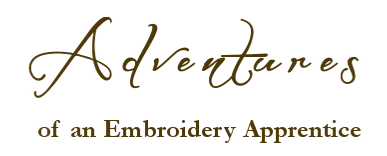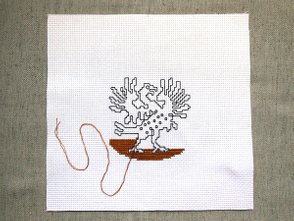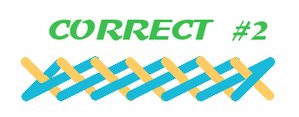Click on the images to enlarge them!
September 2018
Assisi Embroidery
Assisi embroidery is a kind of voided cross stitch embroidery. That is to say, the motif is left blank so that it shows the fabric, only the background is filled with one colour. This style of embroidery was already known in the middle age, save that it didn't come under this name; we actually don't know how they called it in those days. To my knowledge, the name Assisi showed up not until the 19th century / at the turn of the 20th century, when the tradition was revived in the Italian town of Assisi. Assisi work was most often used for religious purposes. The motifs were birds or animals, surrounded by scrollwork, the background stitched in coloured silk on fine linen. The mythical creatures, as we see them today, became popular in the Renaissance era.
The motifs in Assisi work are not always outlined. When they are, it is commonly done in a darker colour, brown or black. The traditional background colours are a muted red, blue, green, brown or a bronze-ish gold. The most frequently used stitch is the long-armed cross stitch, sometimes also the two-sided Italian cross stitch or the Montenegrin stitch, with simple cross stitch rather seldom being found.
The Frightened Chicken
For my Practice Piece, I chose a free pattern from Cross Stitch Club. As I showed it to my partner, he called: "Looks exactly like the chicken I have in the fridge!" - I replied: "It will look like that when you'll take it out of the fridge in order to cook it."
I decided on a dark gold background and black outlines. In order to learn the new stitches, I used Montenegrin stitch, Italian cross stitch, simple cross stitch (ok, this one wasn't new), long-armed cross stitch and Algerian eyes.
The Frightened Chicken
Problems Encountered
As you can see in the photo above, I began stitching the background from the bottom upwards. I stitched the first six rows in Montenegrin stitch, and the second six rows in Italian cross stitch. Next came simple cross stitch, then long-armed cross stitch, and the four rows in the centre are done in Algerian eye stitch. From here onwards to the top the same stitch sequence was applied, only in reversed order.
One row of the Algerian eyes had to span two rows of the Aida threads, because with this stitch, all the "arms" of the star meet in the center, and Aida fabric has this particular weave, in which one row is made of several firmly connected threads without an additional hole in the middle (if you get my meaning). The Aida I've got, is hard as a desk, so that it cannot even be placed in a hoop, let alone pierced through easily by the needle outside of the holes. But as I saw later, the Algerian stitch isn't a traditional stitch in Assisi work, anyway.
The Montenegrin stitch was okay. The Italian cross stitch came off okay, too, save that it "eats" the double length of floss; it's not a very economical stitch. It was the long-armed cross stitch that brought about some confusion. I simply got it wrong and that two times! To spare you a similar bedlam, here are the WRONG and the CORRECT versions (I prefer #2):
It's a plaited stitch, which is to say that you cannot work the lower halves of the crosses first over the whole row, filling up the upper halves when moving back. Rather every cross has to be stitched separately, otherwise it wouldn't result in a plaited pattern.
For a detailed instruction for working the long-armed cross stitch (and all the other versions), have a look at my stitchionary.
Lessons Learned
- As usual in counted cross stitch, I used two strands of cotton to work with. The outline came out okay, but as it came to filling the background, it proved somewhat difficult to place the needle inside the holes in the already existing outline without splitting it up nor covering it with the background thread. That's why I worked the scrollwork with one strand only. I like it pretty much, and in addition it looks more delicate. - Also the background was sometimes difficult to manage with two strands, particularly inside the little squares in the centre of the bird.
- Of course, I've learned a couple of new (cross) stitches: long-armed cross stitch, Italian cross stitch, Montenegrin stitch and Algerian eye stitch.
- It seems common in Assisi embroidery to draw the outlines on the fabric first. However, when you have got a counted pattern that you are able to follow (just like in "normal" cross stitch), you can just as well skip the transfer. That's how I did it.
Assisi Work
I came to like Assisi embroidery very much. It feels good seeing the voided motif evolving clearly out of the background as you go along. Now I'm eager to arrange my first own Assisi sampler ...





